YAMAHA SUPERJET 2022 User Guide
Manufacturer: YAMAHA, Model Year: 2022, Model line: SUPERJET, Model: YAMAHA SUPERJET 2022Pages: 84, PDF Size: 3.76 MB
Page 11 of 84
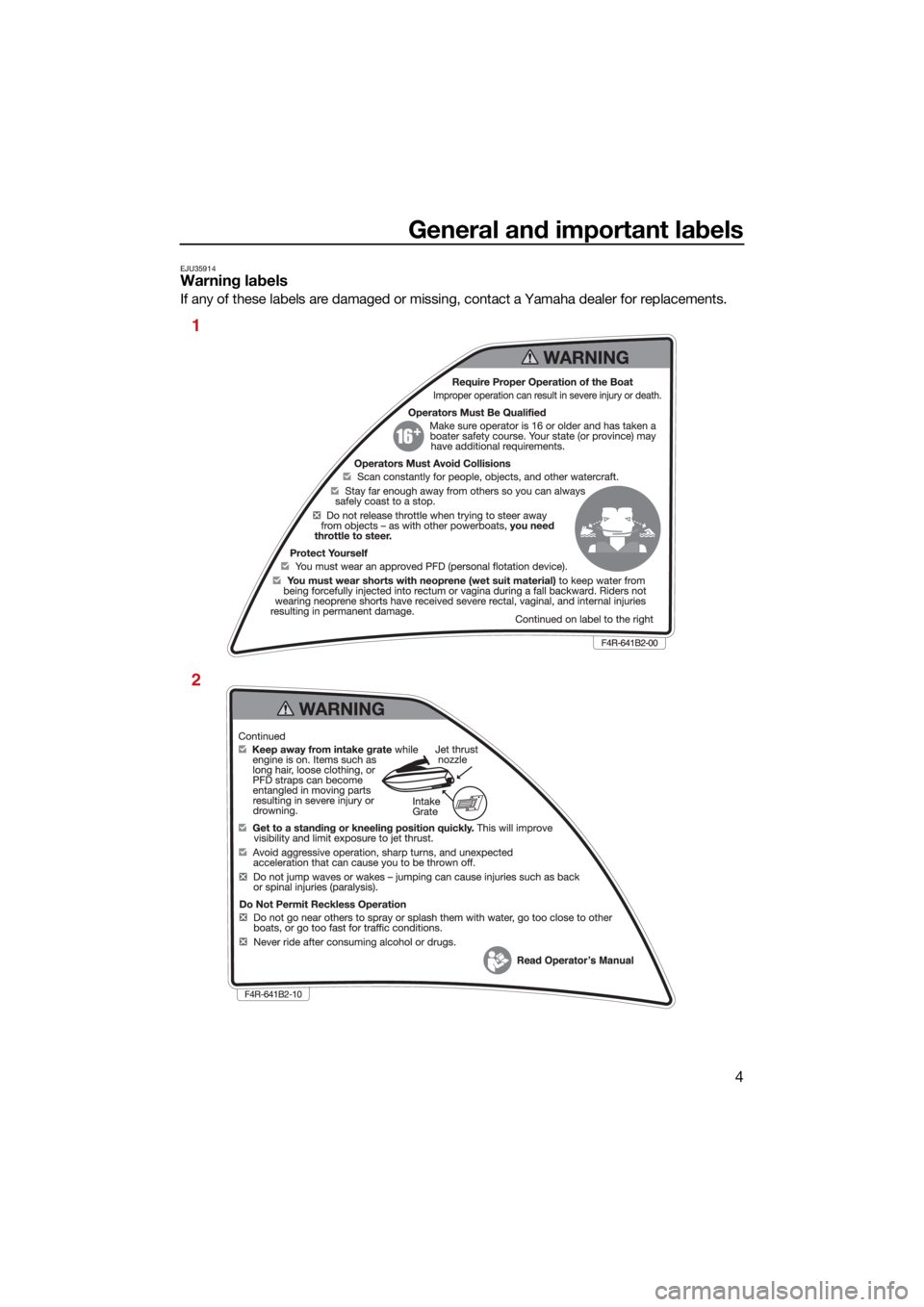
General and important labels
4
EJU35914Warning labels
If any of these labels are damaged or missing, contact a Yamaha dealer for replacements.
1
2
UF4R71E0.book Page 4 Monday, May 10, 2021 1:14 PM
Page 12 of 84
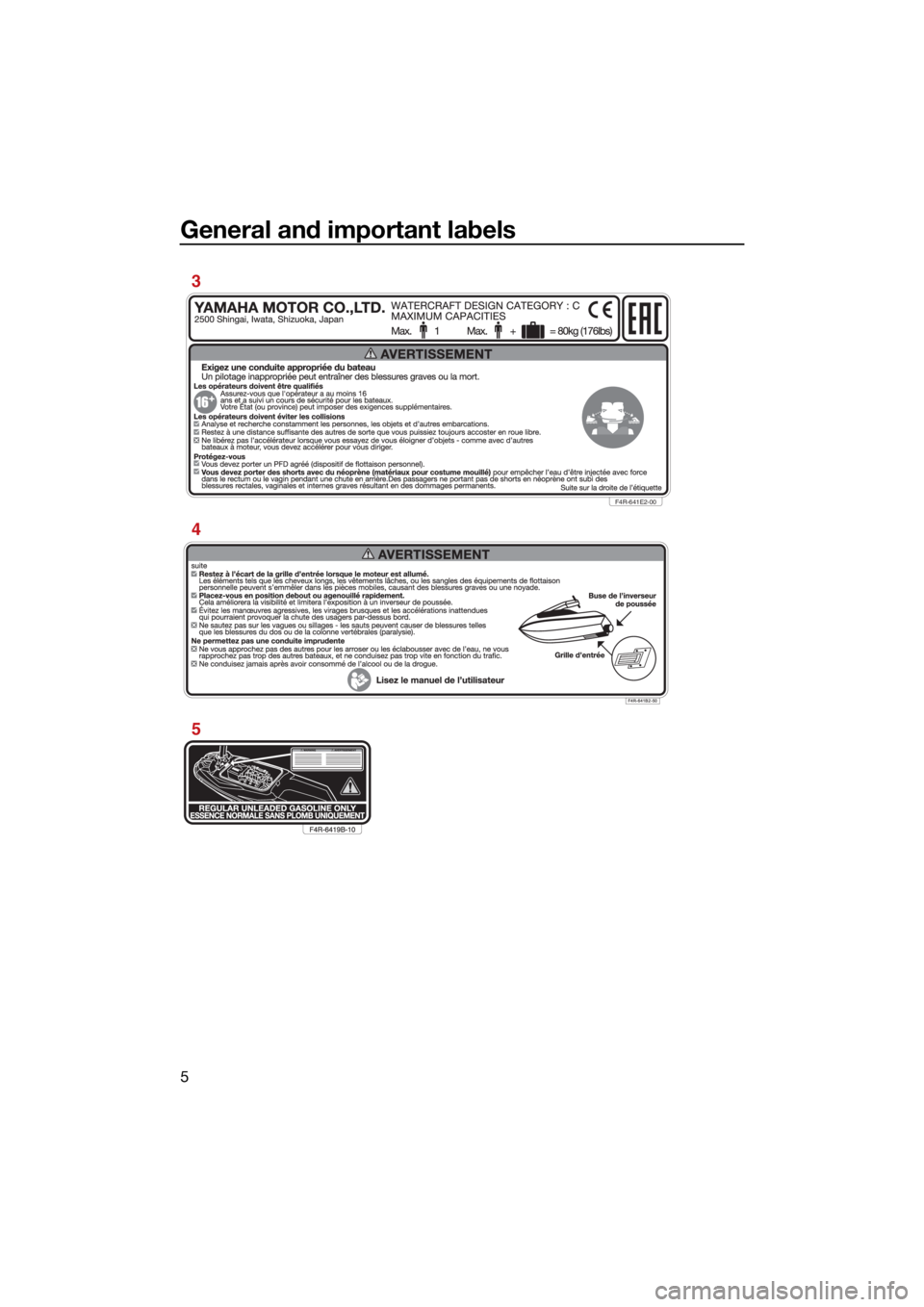
General and important labels
5
F4R-641E2-00
3
4
5
UF4R71E0.book Page 5 Monday, May 10, 2021 1:14 PM
Page 13 of 84
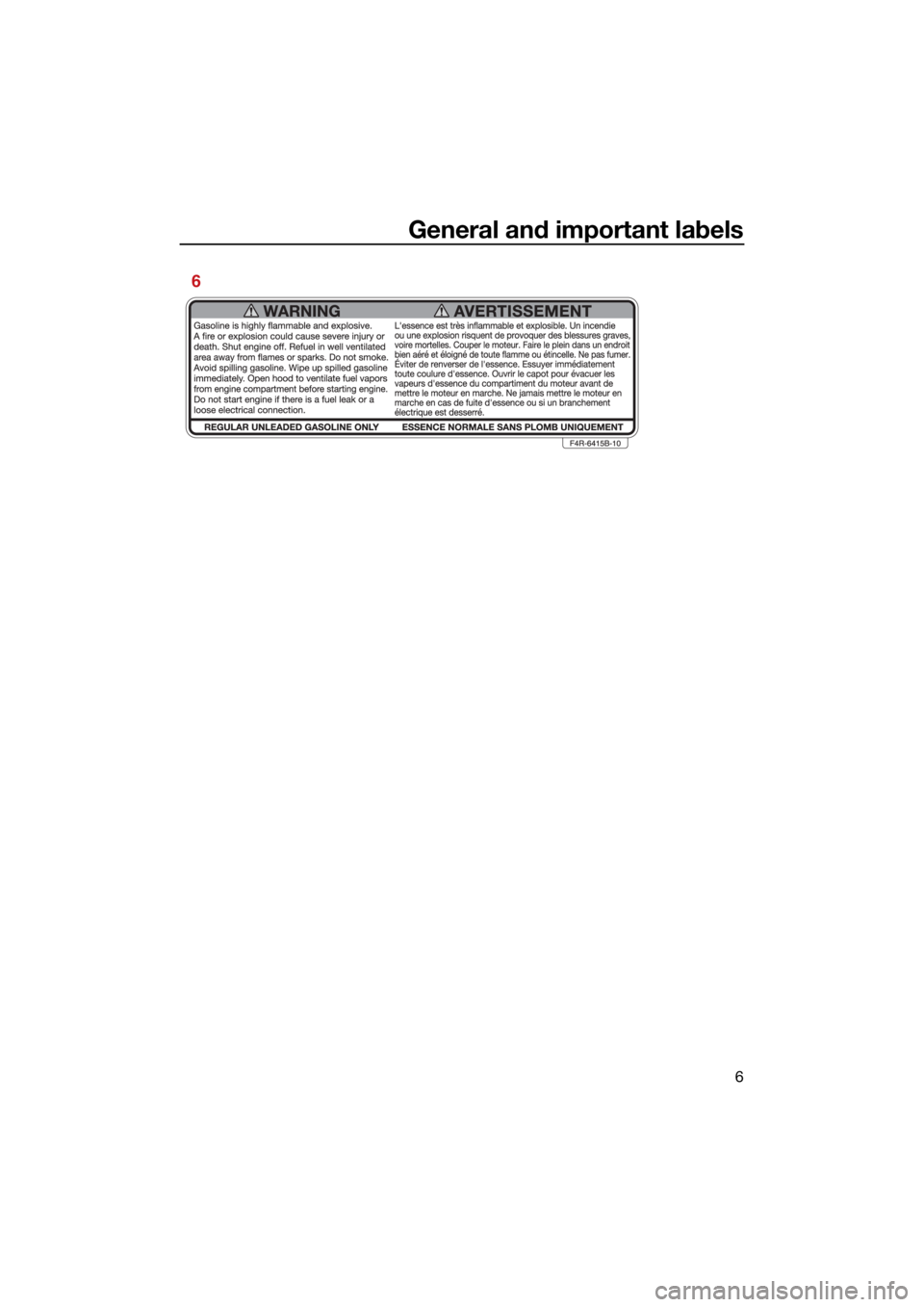
General and important labels
6
6
UF4R71E0.book Page 6 Monday, May 10, 2021 1:14 PM
Page 14 of 84
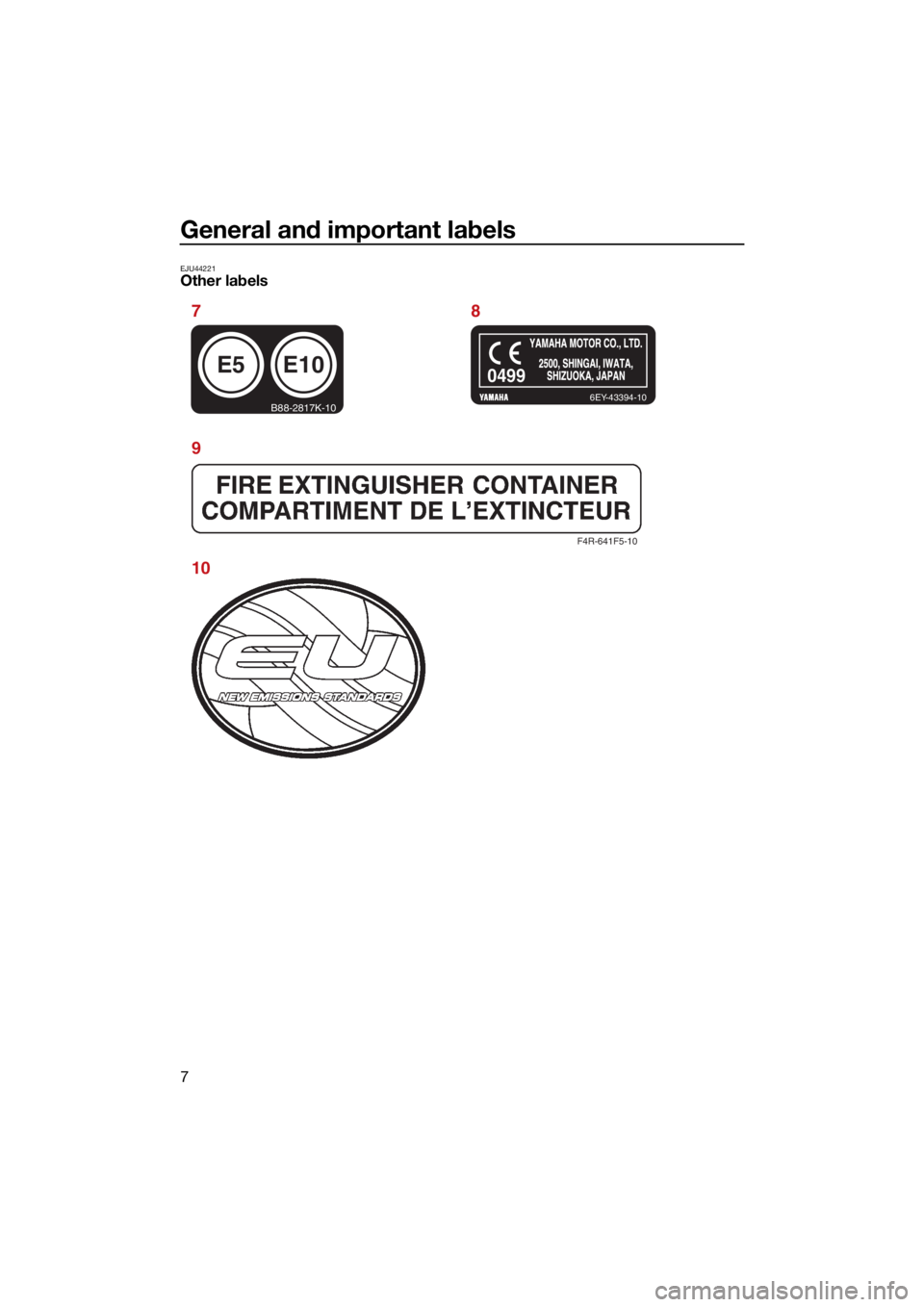
General and important labels
7
EJU44221Other labels
F4R-641F5-10
E5
B88-2817K-10
E10
6EY-43394-10
0499
78
9
10
UF4R71E0.book Page 7 Monday, May 10, 2021 1:14 PM
Page 15 of 84
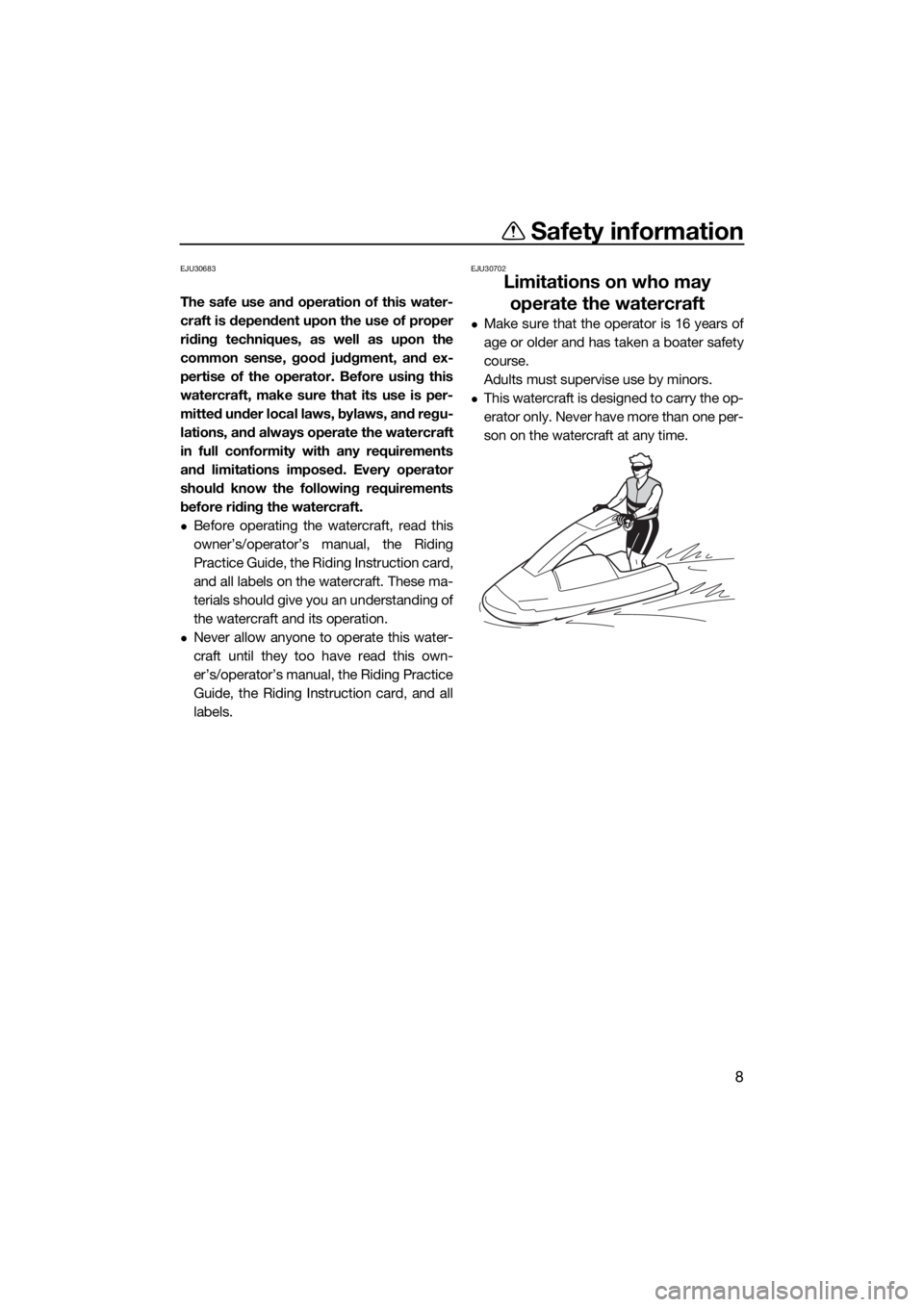
Safety information
8
EJU30683
The safe use and operation of this water-
craft is dependent upon the use of proper
riding techniques, as well as upon the
common sense, good judgment, and ex-
pertise of the operator. Before using this
watercraft, make sure that its use is per-
mitted under local laws, bylaws, and regu-
lations, and always operate the watercraft
in full conformity with any requirements
and limitations imposed. Every operator
should know the following requirements
before riding the watercraft.
Before operating the watercraft, read this
owner’s/operator’s manual, the Riding
Practice Guide, the Riding Instruction card,
and all labels on the watercraft. These ma-
terials should give you an understanding of
the watercraft and its operation.
Never allow anyone to operate this water-
craft until they too have read this own-
er’s/operator’s manual, the Riding Practice
Guide, the Riding Instruction card, and all
labels.
EJU30702
Limitations on who may operate the watercraft
Make sure that the operator is 16 years of
age or older and has taken a boater safety
course.
Adults must supervise use by minors.
This watercraft is designed to carry the op-
erator only. Never have more than one per-
son on the watercraft at any time.
UF4R71E0.book Page 8 Monday, May 10, 2021 1:14 PM
Page 16 of 84
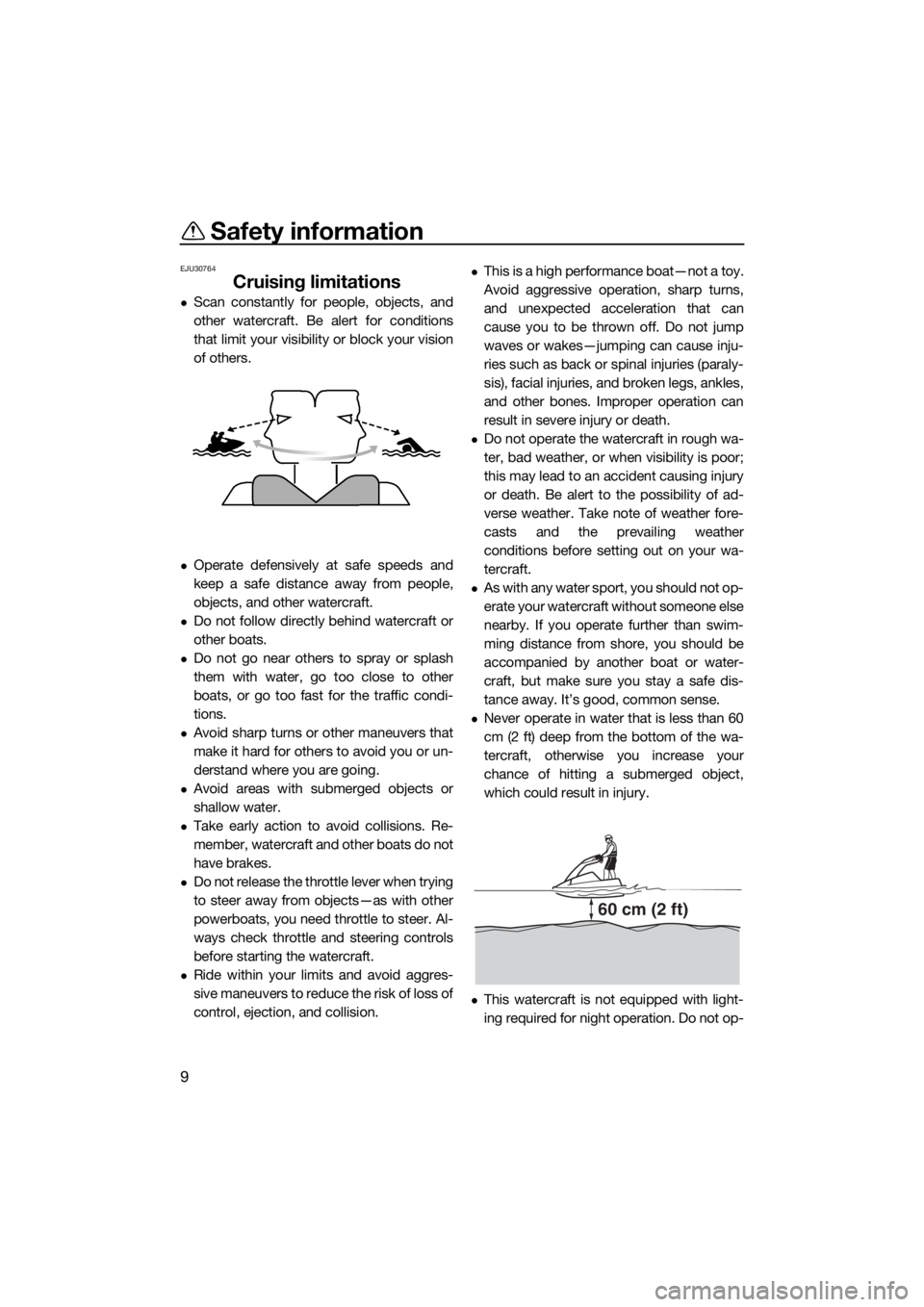
Safety information
9
EJU30764
Cruising limitations
Scan constantly for people, objects, and
other watercraft. Be alert for conditions
that limit your visibility or block your vision
of others.
Operate defensively at safe speeds and
keep a safe distance away from people,
objects, and other watercraft.
Do not follow directly behind watercraft or
other boats.
Do not go near others to spray or splash
them with water, go too close to other
boats, or go too fast for the traffic condi-
tions.
Avoid sharp turns or other maneuvers that
make it hard for others to avoid you or un-
derstand where you are going.
Avoid areas with submerged objects or
shallow water.
Take early action to avoid collisions. Re-
member, watercraft and other boats do not
have brakes.
Do not release the throttle lever when trying
to steer away from objects—as with other
powerboats, you need throttle to steer. Al-
ways check throttle and steering controls
before starting the watercraft.
Ride within your limits and avoid aggres-
sive maneuvers to reduce the risk of loss of
control, ejection, and collision.
This is a high performance boat—not a toy.
Avoid aggressive operation, sharp turns,
and unexpected acceleration that can
cause you to be thrown off. Do not jump
waves or wakes—jumping can cause inju-
ries such as back or spinal injuries (paraly-
sis), facial injuries, and broken legs, ankles,
and other bones. Improper operation can
result in severe injury or death.
Do not operate the watercraft in rough wa-
ter, bad weather, or when visibility is poor;
this may lead to an accident causing injury
or death. Be alert to the possibility of ad-
verse weather. Take note of weather fore-
casts and the prevailing weather
conditions before setting out on your wa-
tercraft.
As with any water sport, you should not op-
erate your watercraft without someone else
nearby. If you operate further than swim-
ming distance from shore, you should be
accompanied by another boat or water-
craft, but make sure you stay a safe dis-
tance away. It’s good, common sense.
Never operate in water that is less than 60
cm (2 ft) deep from the bottom of the wa-
tercraft, otherwise you increase your
chance of hitting a submerged object,
which could result in injury.
This watercraft is not equipped with light-
ing required for night operation. Do not op-
60 cm (2 ft)
UF4R71E0.book Page 9 Monday, May 10, 2021 1:14 PM
Page 17 of 84
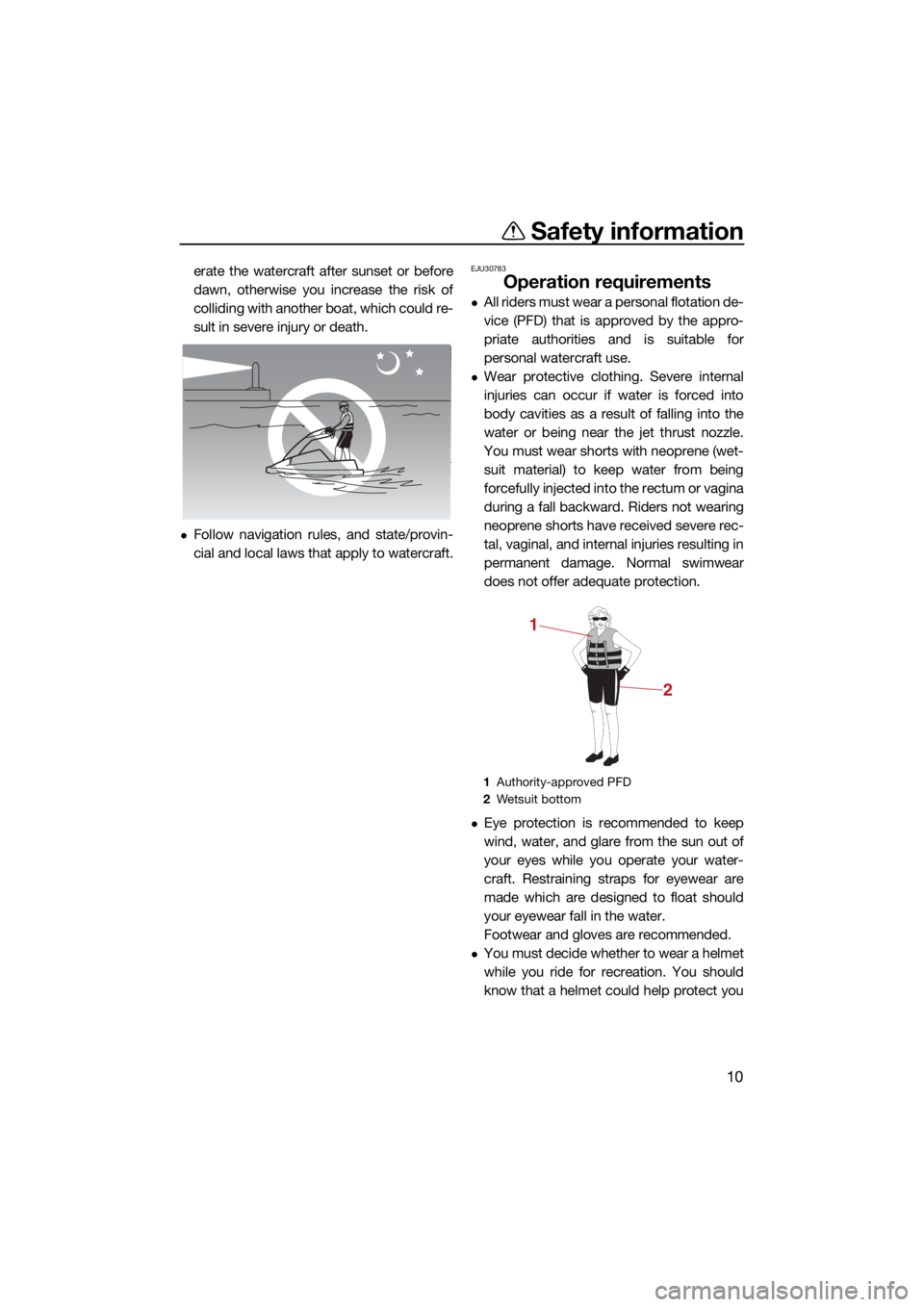
Safety information
10
erate the watercraft after sunset or before
dawn, otherwise you increase the risk of
colliding with another boat, which could re-
sult in severe injury or death.
Follow navigation rules, and state/provin-
cial and local laws that apply to watercraft.
EJU30783
Operation requirements
All riders must wear a personal flotation de-
vice (PFD) that is approved by the appro-
priate authorities and is suitable for
personal watercraft use.
Wear protective clothing. Severe internal
injuries can occur if water is forced into
body cavities as a result of falling into the
water or being near the jet thrust nozzle.
You must wear shorts with neoprene (wet-
suit material) to keep water from being
forcefully injected into the rectum or vagina
during a fall backward. Riders not wearing
neoprene shorts have received severe rec-
tal, vaginal, and internal injuries resulting in
permanent damage. Normal swimwear
does not offer adequate protection.
Eye protection is recommended to keep
wind, water, and glare from the sun out of
your eyes while you operate your water-
craft. Restraining straps for eyewear are
made which are designed to float should
your eyewear fall in the water.
Footwear and gloves are recommended.
You must decide whether to wear a helmet
while you ride for recreation. You should
know that a helmet could help protect you
1Authority-approved PFD
2 Wetsuit bottom
1
2
UF4R71E0.book Page 10 Monday, May 10, 2021 1:14 PM
Page 18 of 84
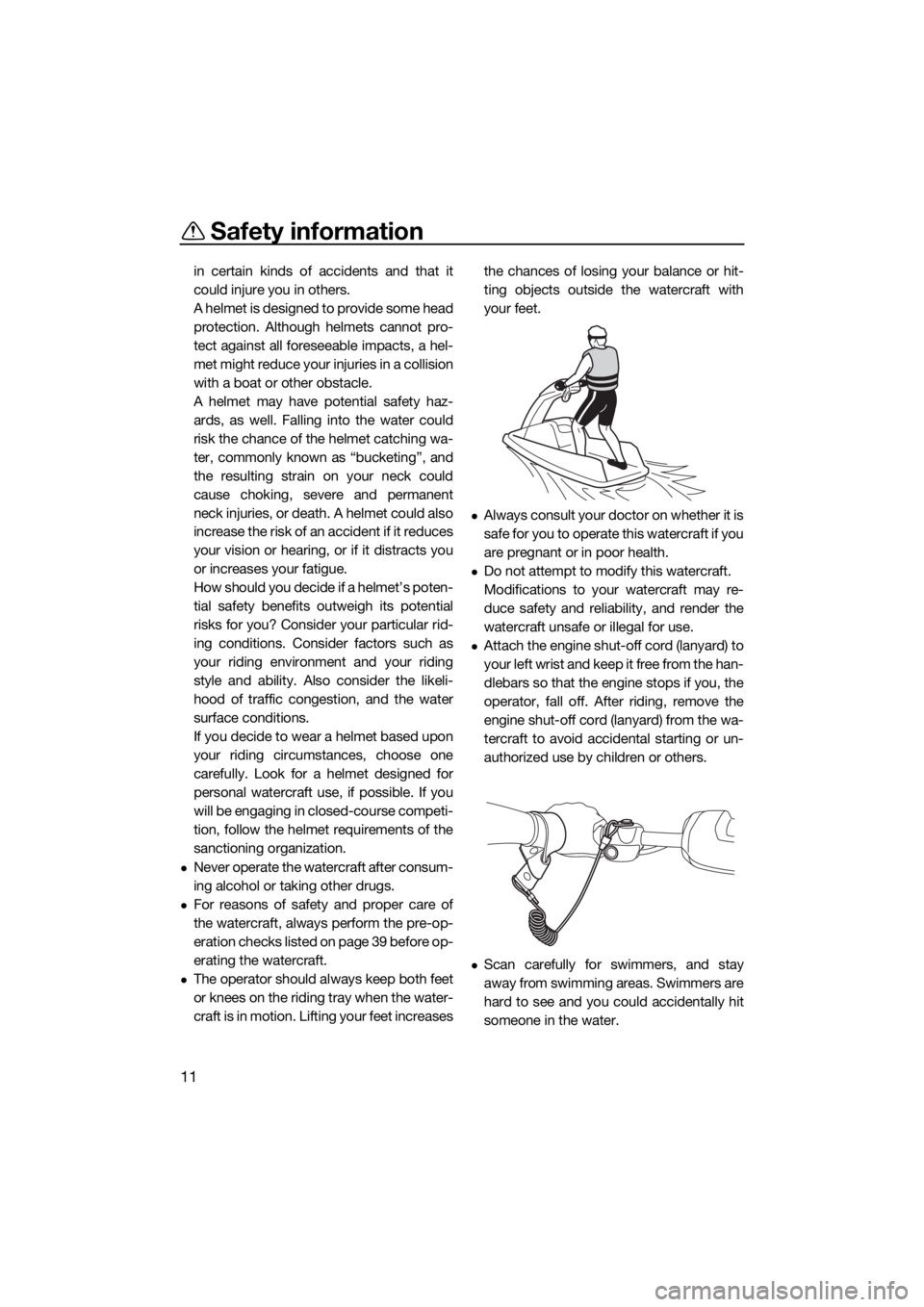
Safety information
11
in certain kinds of accidents and that it
could injure you in others.
A helmet is designed to provide some head
protection. Although helmets cannot pro-
tect against all foreseeable impacts, a hel-
met might reduce your injuries in a collision
with a boat or other obstacle.
A helmet may have potential safety haz-
ards, as well. Falling into the water could
risk the chance of the helmet catching wa-
ter, commonly known as “bucketing”, and
the resulting strain on your neck could
cause choking, severe and permanent
neck injuries, or death. A helmet could also
increase the risk of an accident if it reduces
your vision or hearing, or if it distracts you
or increases your fatigue.
How should you decide if a helmet’s poten-
tial safety benefits outweigh its potential
risks for you? Consider your particular rid-
ing conditions. Consider factors such as
your riding environment and your riding
style and ability. Also consider the likeli-
hood of traffic congestion, and the water
surface conditions.
If you decide to wear a helmet based upon
your riding circumstances, choose one
carefully. Look for a helmet designed for
personal watercraft use, if possible. If you
will be engaging in closed-course competi-
tion, follow the helmet requirements of the
sanctioning organization.
Never operate the watercraft after consum-
ing alcohol or taking other drugs.
For reasons of safety and proper care of
the watercraft, always perform the pre-op-
eration checks listed on page 39 before op-
erating the watercraft.
The operator should always keep both feet
or knees on the riding tray when the water-
craft is in motion. Lifting your feet increases the chances of losing your balance or hit-
ting objects outside the watercraft with
your feet.
Always consult your doctor on whether it is
safe for you to operate this watercraft if you
are pregnant or in poor health.
Do not attempt to modify this watercraft.
Modifications to your watercraft may re-
duce safety and reliability, and render the
watercraft unsafe or illegal for use.
Attach the engine shut-off cord (lanyard) to
y o u r l ef t w r is t an d k ee p i t fr e e f r o m t h e h an -
dlebars so that the engine stops if you, the
operator, fall off. After riding, remove the
engine shut-off cord (lanyard) from the wa-
tercraft to avoid accidental starting or un-
authorized use by children or others.
Scan carefully for swimmers, and stay
away from swimming areas. Swimmers are
hard to see and you could accidentally hit
someone in the water.
UF4R71E0.book Page 11 Monday, May 10, 2021 1:14 PM
Page 19 of 84

Safety information
12
Avoid being hit by another boat. You
should always take the responsibility to
watch for traffic; other boaters may not be
watching for you. If they do not see you, or
if you maneuver more quickly than other
boaters expect, you risk a collision.
Maintain a safe distance from other boats
and watercraft, and also watch for ski
ropes or fishing lines. Obey the “Safe boat-
ing rules” and be sure to check behind you
before making a turn. (See “Safe boating
rules” on page 14.)
EJU30841
Recommended equipment
The following items should be carried on
board your watercraft:
Sound-signaling device
You should carry a whistle or other sound-
signaling device that can be used to signal
other boats.
Visual distress signals
It is recommended that a pyrotechnic de-
vice, which is approved by the appropriate
authorities, be stored in a waterproof con-
tainer on your watercraft. A mirror can also
be used as an emergency signal. Contact a
Yamaha dealer for more information.
Watch
A watch is helpful so you will know how
long you have been operating the water-
craft.
Towline
A towline can be used to tow a disabled
watercraft in an emergency.
UF4R71E0.book Page 12 Monday, May 10, 2021 1:14 PM
Page 20 of 84

Safety information
13
EJU30872
Hazard information
Never start the engine or let it run for any
length of time in an enclosed area. Exhaust
fumes contain carbon monoxide, a color-
less, odorless gas that may cause loss of
consciousness and death within a short
time. Always operate the watercraft in an
open area.
Do not touch the hot oil tank, muffler, or en-
gine during or immediately after engine op-
eration; they can cause serious burns.
EJU30883
Watercraft characteristics
Jet thrust turns the watercraft. Releasing
the throttle lever completely produces only
minimum thrust. If you are traveling at
speeds above trolling, you will have rapidly
decreasing ability to steer without throttle.
You may still have some turning ability im-
mediately after releasing the throttle lever,
but once the engine slows down, the wa-
tercraft will no longer respond to handlebar
input until you apply throttle again or you
reach trolling speed.
Practice turning in an open area without
obstacles until you have a good feel for this
maneuver.
This watercraft is water-jet propelled. The
jet pump is directly connected to the en-
gine. This means that jet thrust will produce
some movement whenever the engine is
running. There is no “neutral” position.
Keep away from the intake grate while the
engine is on. Items such as long hair, loose
clothing, or PFD straps can become entan-
gled in moving parts, resulting in severe in-
jury or drowning.
Never insert any object into the jet thrust
nozzle while the engine is running. Severe
injury or death could result from coming in
UF4R71E0.book Page 13 Monday, May 10, 2021 1:14 PM